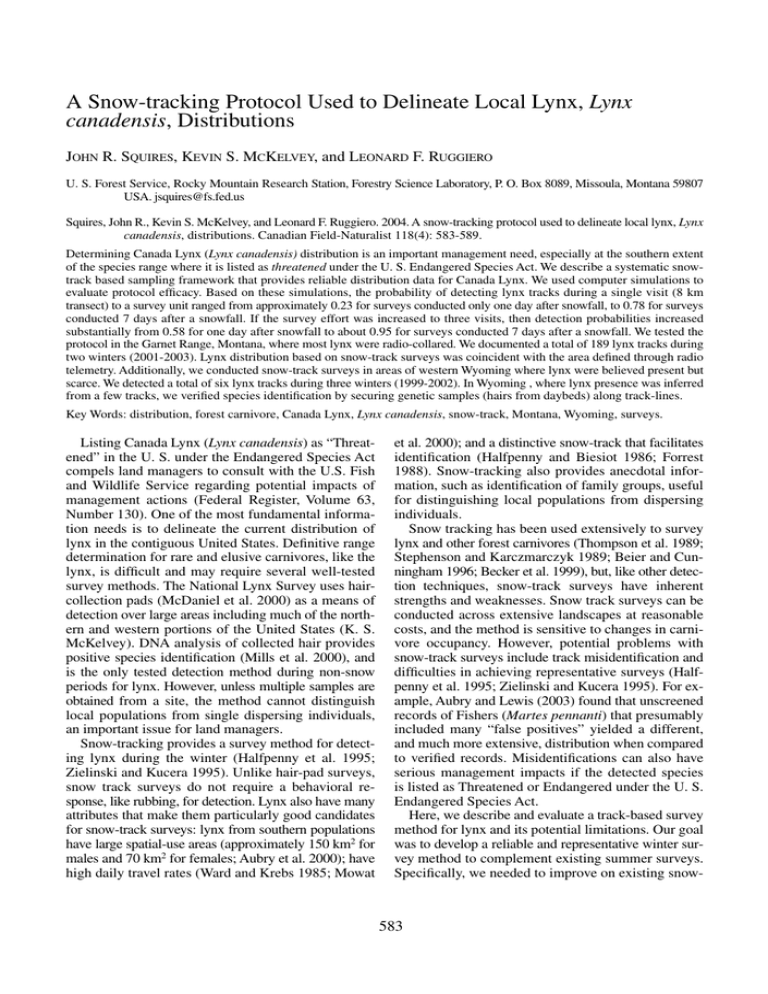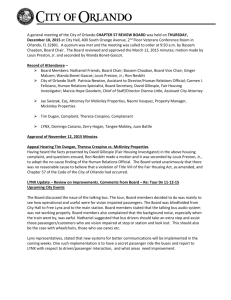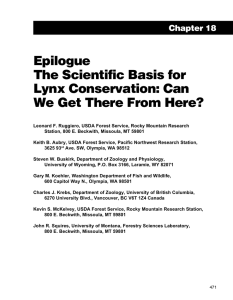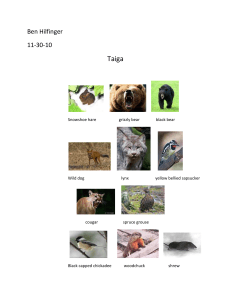Lynx , Distributions canadensis J
advertisement

A Snow-tracking Protocol Used to Delineate Local Lynx, Lynx canadensis, Distributions JOHN R. SQUIRES, KEVIN S. MCKELVEY, and LEONARD F. RUGGIERO U. S. Forest Service, Rocky Mountain Research Station, Forestry Science Laboratory, P. O. Box 8089, Missoula, Montana 59807 USA. jsquires@fs.fed.us Squires, John R., Kevin S. McKelvey, and Leonard F. Ruggiero. 2004. A snow-tracking protocol used to delineate local lynx, Lynx canadensis, distributions. Canadian Field-Naturalist 118(4): 583-589. Determining Canada Lynx (Lynx canadensis) distribution is an important management need, especially at the southern extent of the species range where it is listed as threatened under the U. S. Endangered Species Act. We describe a systematic snowtrack based sampling framework that provides reliable distribution data for Canada Lynx. We used computer simulations to evaluate protocol efficacy. Based on these simulations, the probability of detecting lynx tracks during a single visit (8 km transect) to a survey unit ranged from approximately 0.23 for surveys conducted only one day after snowfall, to 0.78 for surveys conducted 7 days after a snowfall. If the survey effort was increased to three visits, then detection probabilities increased substantially from 0.58 for one day after snowfall to about 0.95 for surveys conducted 7 days after a snowfall. We tested the protocol in the Garnet Range, Montana, where most lynx were radio-collared. We documented a total of 189 lynx tracks during two winters (2001-2003). Lynx distribution based on snow-track surveys was coincident with the area defined through radio telemetry. Additionally, we conducted snow-track surveys in areas of western Wyoming where lynx were believed present but scarce. We detected a total of six lynx tracks during three winters (1999-2002). In Wyoming , where lynx presence was inferred from a few tracks, we verified species identification by securing genetic samples (hairs from daybeds) along track-lines. Key Words: distribution, forest carnivore, Canada Lynx, Lynx canadensis, snow-track, Montana, Wyoming, surveys. Listing Canada Lynx (Lynx canadensis) as “Threatened” in the U. S. under the Endangered Species Act compels land managers to consult with the U.S. Fish and Wildlife Service regarding potential impacts of management actions (Federal Register, Volume 63, Number 130). One of the most fundamental information needs is to delineate the current distribution of lynx in the contiguous United States. Definitive range determination for rare and elusive carnivores, like the lynx, is difficult and may require several well-tested survey methods. The National Lynx Survey uses haircollection pads (McDaniel et al. 2000) as a means of detection over large areas including much of the northern and western portions of the United States (K. S. McKelvey). DNA analysis of collected hair provides positive species identification (Mills et al. 2000), and is the only tested detection method during non-snow periods for lynx. However, unless multiple samples are obtained from a site, the method cannot distinguish local populations from single dispersing individuals, an important issue for land managers. Snow-tracking provides a survey method for detecting lynx during the winter (Halfpenny et al. 1995; Zielinski and Kucera 1995). Unlike hair-pad surveys, snow track surveys do not require a behavioral response, like rubbing, for detection. Lynx also have many attributes that make them particularly good candidates for snow-track surveys: lynx from southern populations have large spatial-use areas (approximately 150 km2 for males and 70 km2 for females; Aubry et al. 2000); have high daily travel rates (Ward and Krebs 1985; Mowat et al. 2000); and a distinctive snow-track that facilitates identification (Halfpenny and Biesiot 1986; Forrest 1988). Snow-tracking also provides anecdotal information, such as identification of family groups, useful for distinguishing local populations from dispersing individuals. Snow tracking has been used extensively to survey lynx and other forest carnivores (Thompson et al. 1989; Stephenson and Karczmarczyk 1989; Beier and Cunningham 1996; Becker et al. 1999), but, like other detection techniques, snow-track surveys have inherent strengths and weaknesses. Snow track surveys can be conducted across extensive landscapes at reasonable costs, and the method is sensitive to changes in carnivore occupancy. However, potential problems with snow-track surveys include track misidentification and difficulties in achieving representative surveys (Halfpenny et al. 1995; Zielinski and Kucera 1995). For example, Aubry and Lewis (2003) found that unscreened records of Fishers (Martes pennanti) that presumably included many “false positives” yielded a different, and much more extensive, distribution when compared to verified records. Misidentifications can also have serious management impacts if the detected species is listed as Threatened or Endangered under the U. S. Endangered Species Act. Here, we describe and evaluate a track-based survey method for lynx and its potential limitations. Our goal was to develop a reliable and representative winter survey method to complement existing summer surveys. Specifically, we needed to improve on existing snow- 583 584 THE CANADIAN FIELD-NATURALIST track survey methodologies to ensure they are representative in terms of their spatial extent and habitat coverage, and to address problems of track misidentification by incorporating genetic sampling (i.e., scats and hairs frozen in tracks and daybeds). To evaluate reliability we tested these methods both through computer simulation and through direct comparisons with radio-telemetry data in an area where most lynx were radio-collared. Study Areas We conducted lynx surveys in the Garnet Mountain Range of western Montana, and in the Wyoming/Salt River Mountains approximately 80 km southwest of Jackson, Wyoming. Approximately 80% of the Garnet Range is forested within the Douglas-fir (Pseudotsuga menziesii) and Subalpine Fir (Abies lasiocarpa) series of the Montana Forest Habitat type (Pfister et al. 1977; Burcham et al. 1999). Dominant tree species include Subalpine Fir, Engelmann Spruce (Picea engelmannii), Lodgepole Pine (Pinus contorta), and Douglas-fir. Elevations range from 1160 to 2090 m. The primary use of forested public and private lands is timber management, and much of the area was extensively logged within the past 25 years. The Garnet Range is adjacent to private lands that consist mainly of irrigated hay fields and Big Sage Brush (Artemisia tridentata) – wheat grass (Agropyron spp.) cover types. The Wyoming and Salt River ranges, located in westcentral Wyoming, support mixed conifer forests that include Subalpine Fir, Engelmann Spruce, Lodgepole Pine, Whitebark Pine (Pinus albicaulis), Douglas-fir, and Quaking Aspen (Populus tremuloides). Mesic sites are dominated by Subalpine fir and Engelmann Spruce forests in seasonally moist or wet areas, or where subirrigation maintains a high water table. Spruce-fir forests are typically co-dominant with Lodgepole Pine. Dry sites are dominated by Lodgepole Pine forests, often intermixed with Douglas-fir and Quaking Aspen. Pre- Vol. 118 cipitation is mostly in the form of snow; elevations range from 1981 – 3353 m. Methods Modeling Track Detections We estimated the probability of detection relative to search effort using computer simulation to model track detections based on the tortuosity of actual lynx tracks. As part of our research, we back-tracked 15 radio-collared lynx and mapped their tracks using a Trimble GEO Explorer III‚ with data points taken at 2 s intervals. We randomly selected one 3-km track from each lynx and calculated the average track tortuosity by dividing total length by the linear distance traveled (Turchin 1998). This result was used when generating simulated tracks to ensure realistic track tortuosity. Computer simulations required that we estimate daily travel distances of lynx. Daily movements as measured by radio telemetry are shorter than the animal’s actual movement because of unrecorded tortuosity. In general, reported daily movements of lynx ranged from 1-9 km as measured using various methods, with most estimates from 1-4 km (Table 1). For modeling, we assumed that daily movements varied randomly from 1.0-4.0 km (χ− = 2.5 km). We chose a conservative estimate of daily movements to better ensure that our model results addressed locating lynx at low densities where tracks were uncommon. A uniformlydistributed random number was drawn from this range for each trial. A simulated day’s movement was completed when the linear distance traveled between the day’s start and the current location exceeded the drawn random number. The program continued in this manner counting the number of days elapsed until the survey transect intersected a simulated track, and the number of elapsed days was written to an output file. Simulated tracks began at random locations within hypothetical, circular home ranges of 100 km2 with TABLE 1. Reported daily distances for lynx movement; only winter movements were included where both summer and winter movements were reported. Study Distance (km) Method Parker et al. 1983 8.8, male 7.6, female 6.5, juvenile 2.7 (95% CI = 1.8-3.7), hares common 2.4 (95% CI = 2.0-2.9), hares uncommon 1.0, (range = 0.02–7.4), males 0.7, (range = 0.02-4.0), females 3.8 (sd = 0.6), male 3.0 (sd = 0.4) female 5-9 reported average of multiple studies 2.8 (range = 2.5-3.3), 4 Montana males 3.2 (range = 2.5-3.9), 3 Montana females 2.7 (range = 0.7-9.5), Wyoming male 2.2 (range = 0.3-5.2), Wyoming female Cumulative distance based on 2 hour relocations Ward and Krebs 1985 Brittell et al. 1989 Apps 2000 Mowat et al. 2000 Squires and Laurion 2000 Daily telemetry locations Daily telemetry locations Daily telemetry locations Snow tracking Daily telemetry locations 2004 SQUIRES, MCKELVEY, and RUGGIERO: SNOW-TRACKING PROTOCOL an initial random direction. The length of simulated tracks was evaluated using travel distances that would be expected if we assumed that 1, 3, or 7 days had elapsed since the most recent snowfall. The survey route was modeled as a straight, 8-km transect, randomly located within the 100 km2 home range. The entire transect was incorporated into the home range, an assumption based on the study design in which the simulated survey track would be replicated within each cell of a contiguous grid. Hence, at least 8 linear km of survey track would be found in any arbitrary 100 km2 circular area within the survey. Snow-track Protocol We used GIS to establish an 8 × 8 km grid across each survey area to define sample units. The size of this sample unit was slightly smaller than a typical female home range (Aubry et al. 2000) and was employed to reduce the chance of missing individuals, but was still efficient for searching large landscapes (Zielinski et al. 1995). Female lynx typically have smaller home ranges than males (Koehler 1990; Poole 1994; Slough and Mowat 1996). Establishing a grid of survey units covering the study areas ensured that our search effort was spatially well distributed across available habitats (Zielinski et al. 1995). After establishing the sample grids, we assigned a high or low priority to sampling units based on dominant habitat-type. Sample units in moist, Subalpine Fir forests were a high priority because these stands are more heavily used by lynx than drier forest types (McKelvey et al. 2000). Our protocol specified that “high” priority units be surveyed at least twice per winter (Halfpenny et al. 1995). Open-forest types, such as dry Lodgepole Pine, Quaking Aspen, and Ponderosa Pine (Pinus ponderosa), were “low” priority and were only searched once per winter. Open habitat types (large park lands, sage brush, tundra, agriculture) and high elevation sites (tundra, rock, and ice) are rarely used by lynx (Koehler 1990; Aubry et al. 2000; McKelvey et al. 2000) and were not surveyed. Observers primarily searched for animal tracks by traveling 15-20 km/hr on roads and trails using snowmobiles. We saw no evidence that lynx were reluctant to cross snowed-in logging roads and trails (Squires; unpublished data; see also O’Donoghue et al. 1998). Survey units that could not be surveyed by snowmobile were searched on snowshoes to the extent possible. The protocol specified that we search 10 km in each 8 × 8 km sample unit choosing routes that preferentially traversed forested habitats with high horizontal cover. This search effort per sample unit was sufficient to traverse key areas within the unit, but still allowed us to efficiently search multiple sample units per day. High horizontal cover is an important component of Snowshoe Hare (Lepus americanus) habitat, the dominant prey species of lynx (Hodges 2000). Sample units that contained only dry, open forests were surveyed using routes that best bisected the search area. Our 585 goal was a representative survey of sample units that were spatially well distributed across available habitats, while preferentially searching the best habitats in each unit to maximize the chance of detecting lynx. We recorded the locations of all lynx tracks and the tracks of other carnivores using a Trimble GEO Explorer III‚ GPS. Multiple crossings known to be the same animal and <100 m apart were recorded as a single detection. We measured (stride, straddle, length, width, depth; Halfpenny et al. 1995) and photographed all rare carnivore tracks to provide documentation. Track misidentification is a potential problem of snow-based surveys (Zielinski and Kucera 1995; Halfpenny et al. 1995), especially in areas where the species of interest is rare. We collected genetic samples (e.g., hairs, scats) from snow-tracks on the Wyoming study area to provide unequivocal documentation. To collect genetic samples, we followed presumed lynx tracks in search of scats or day beds. We carefully removed loose snow from daybeds until we reached the frozen bed layer. We then thoroughly searched the snow surface and used tweezers to secure hairs frozen in the snow. Hairs were stored in desiccant until the Rocky Mountain Research Station’s Wildlife Genetics Laboratory, Missoula, Montana, extracted and analyzed DNA samples. Snow-track surveys require trained personnel to be effective (Zielinski and Kucera 1995). We trained observers at our long-term lynx study area near Seeley Lake, Montana. Observers back-tracked radio-collared lynx to practice identifying tracks under diverse environmental conditions (e.g., forest type, snow conditions, topography). Following this training, we assumed that all observers could recognize lynx tracks. Survey Verification In the Garnet Range, we used radio-telemetry data to determine if the distribution of lynx within the study area was coincident with survey results. Lynx were trapped using specially designed box traps baited with carrion, beaver castor, and pie plates and wings for visual lures (Kolbe et al. 2003). Trapping was conducted throughout the winters of 2001-02 and 2002-03. Lynx were chemically immobilized using a syringe pole to administer a mixture of ketamine (10 mg/kg Ketaset®; concentration 100 mg/mL) and xylazine (1 mg/kg; concentration 100 mg/mL); this dose produced predictable immobilization periods (30-40 minutes) and stable vital signs. We fitted adult lynx with VHF radio transmitters (170 g), weighed, measured, and extracted blood from each for future DNA analysis. Kittens were fitted with a padded, 100 g collar that allowed for growth. We monitored lynx movements using aerial telemetry (90% of locations) approximately twice per month augmented with ground-based telemetry. We combined all relocation points and calculated a 95% kernel home range to delineate the distribution of the local lynx population based on telemetry (Worton 1989; Seaman et al. 1999). We then overlaid a 95% 586 THE CANADIAN FIELD-NATURALIST Vol. 118 fixed kernel home range on the distribution of lynx, as delineated by snow tracking, to determine if the two methods yielded coincident distributions. Results Simulations of track detections Computer simulations of track detections indicated different asymptotic relationships between the probability of detection and survey effort (number of visits per winter), based on the time between snowfalls sufficient to obliterate tracks (Figure 1). The probability of detecting lynx tracks during a single visit (8 km transect) to a survey unit ranged from approximately 0.23 for surveys conducted only one day after snowfall, to 0.78 for surveys conducted 7 days after a snowfall. If the survey effort was increased to three visits, then detection probabilities increased substantially from 0.58 for one day after snowfall to about 0.95 for surveys conducted 7 days after a snowfall. Even a modest survey effort of two visits would detect tracks approximately 80% of the time, provided more than 3 days had passed since the last snowfall. Field test – Garnet Range, Montana During winters 2001-2002 and 2002-2003, we surveyed for lynx on 242 km and 438 km of roads and trails, respectively. We documented 37 track detections of lynx in 4 of 12 survey units during winter 20012002, and 37 detections in 4 of 16 survey units during winter 2002-2003. In addition, we observed 115 lynx tracks during winter 2001-2002 and 53 in 2002-2003 in survey units, but not during the formal survey. These detections were made during trapping and related travel. We encountered a higher number of track-crossings during trapping because we only trapped in areas of high lynx use. The average elevation where we located lynx tracks was 1839 m (SD 97, range 1443 – 2012 m). We trapped five lynx during winter 2001-2002, and two additional individuals during winter 2002-2003. We believed this sample of radio-collared individuals was a local census of lynx in the Garnet Range based on trapping results, recaptures, and field observations, but we could not formally test this perception. Field test – Wyoming and Salt River Ranges, Wyoming We conducted track-surveys for lynx in Wyoming during the winters of 1999-2000, 2000-2001, 20012002. During winter 1999-2000, we surveyed 1055 km in 32 sample units, and we detected one lynx track in the Salt River Range and a second track in the northeastern portion of the Wyoming Range. In addition, tracks from a family group were observed in the northeastern portion of the Wyoming Range by Wyoming Game and Fish Department biologists (B. Oakleaf, personal communication 2000). During winter 20002001, we surveyed 1103 km in 37 sample units, and 4 lynx tracks were detected in the northeastern portion of the Wyoming Range, and one set in the southwestern FIGURE 1. Computer-modeled relationship between the probability of detecting lynx and the number of visits to an 8 km survey transect pixel relative to the number of days since last snow. Salt River Range. We surveyed 1080 km in 34 sample units during winter 2001-2002 and detected no lynx. Two tracks located during the 1999-2000 survey looked like lynx, but were poorly defined with each impression being a pedestal above the snow surface as a result of wind scouring. We followed two tracks for approximately 200 m until we located daybeds and collected five hairs. Two of the hairs contained sufficient DNA to amplify and the species identification was verified as lynx. Survey Verification The distribution of lynx in the Garnet Range, as defined by a 95% fixed kernel home range of all marked animals (n= 96 locations from 7 individuals, = 14 locations per individual, Figure 2B) combined, subsumed 97% of all tracks detected during snow-track surveys. The general distribution of lynx in the Garnet Range as defined by radio telemetry and snow-track surveys was coincident (Figure 2A). We documented too few lynx detections in the Wyoming and Salt River ranges to delineate a distribution based on snow-track surveys. However, biologists with the Wyoming Game and Fish Department trapped two lynx in the northeastern portion of the Wyoming Range during the winter of 1996-1997 (B. Oakleaf personal communication 2000). The winter home ranges of these two individuals were restricted to the northeastern portion of the Wyoming Range in the same approximate area as 5 of the 7 track detections from our survey. Discussion Snow-tracking has been used to document the presence/absence of carnivores (Zielinski and Kucera 1995), and continues to be an important technique, especially when the organisms of interest are rare and difficult to observe. One primary appeal of using track-based surveys for presence/absence sampling is the method’s 2004 SQUIRES, MCKELVEY, and RUGGIERO: SNOW-TRACKING PROTOCOL 587 A. B. FIGURE 2. The local distribution of lynx in the Garnet Range delineated from: (A) radio telemetry of all individuals combined (95% fixed kernal, n = 96 locations from 7 individuals, χ− = 13 locations per individual) compared to, (B) the local distribution based on sample units with track detections. 588 THE CANADIAN FIELD-NATURALIST sensitivity to changes in use patterns, especially for species like lynx that are highly mobile and have large home ranges (Ward and Krebs 1985; Poole 1994; Slough and Mowat 1996; Aubry et al. 2000). Changes in lynx occupancy can be quickly detected across extensive areas using snow-track surveys. For example, general occurrence data from 1842-1998 suggested that lynx had a long-term history of occupancy in the Salt River and Wyoming Ranges (see McKelvey et al. 2000: Figure 8.17), and the perception that lynx were currently distributed throughout the Wyoming and Salt River Ranges was shared by local managers. Snow-track surveys conducted in a representative manner throughout the Wyoming and Salt River Mountain ranges provided evidence that lynx were present in 1999, and this result was confirmed using genetic analyses in 2000. However, the low overall detection rate coupled with the lack of tracks in 2001 indicated that lynx were rare and only located in a small area in the northern part of the Wyoming range. In areas with many track detections, snow-track surveys can yield more than simple presence/absence data. Results from the Garnet Range demonstrated that snowtrack surveys conducted in a representative manner can also be used to delineate the local distribution of lynx. The high overlap in distributions determined through telemetry and survey data suggested that snow-track surveys can at least coarsely define the local distribution of lynx (Figure 2). We acknowledge that survey data are more limited than telemetry data given that only winter movements are documented and the resulting distribution is coarse-scale relative to the sample unit. However, even a coarse-scale understanding of local distributions is useful to habitat managers. Thus, based on our data in the Garnet Range, we believe that snowtrack surveys that are spatially well distributed across all available habitats can be used to estimate the local distribution of lynx during the winter. If lynx are abundant in an area, a 5% misidentification rate would have little impact on management decisions. However, in areas where lynx are very rare, a track misidentification can have serious management ramifications. One way to address the chronic problem of track misidentification is to view the track as a “collection device” for obtaining genetic samples rather than a primary method of species identification. Genetic verification provides definitive species documentation, regardless of the observer’s ability to identify rare carnivores based on track characteristics. We therefore recommend that genetic identification be included whenever proper identification of an individual set of tracks is critical. Snow-track surveys are labor intensive, and we have only used this method at a mid or “meso” spatial scale, where we searched all sample units. Such an intensive approach would be impractical across large landscapes, for example a large portion of a state. Although we have not conducted a snow-track based survey at a Vol. 118 “state” scale, adaptive cluster sampling may provide a promising method of achieving a representative sample across very large landscapes (Thompson 1992). Adaptive cluster sampling is effective for delineating clumped distributions, which we believe is the case for lynx at the southern extent of the species’ range (Aubry et al. 2000). Snow-track surveys are often conducted when track characteristics are most distinctive, usually within a day or two following fresh snowfall. This constraint limits the utility of snow tracking because the probability of detecting lynx and other rare carnivores is a function of the time since last snow. The more time that lynx have to travel and establish long tracks, the more likely it is that their tracks will be detected on a survey route. For example, our simulations suggest almost a 100% probability of detecting lynx in two entries 7 days after a snowfall compared to a 43% probability of detection if the area was searched 1 day from snowfall (Figure 1). In the areas we surveyed, snow accumulations over 5 cm were recorded on 22 and 24 17-18% of the days for the Garnet and Wyoming ranges, respectively, and the snow-free periods between storms varied from 4-6 days (U.S.D.A., Natural Resources Conservation Service, SNOTEL data). The ability to correctly identify “old” tracks by incorporating genetic samples allows biologists to survey for rare carnivores when the probability of detection is high, even under poor tracking conditions. The winter surveys that we used to detect lynx in Wyoming and Montana had the following key elements: (1) sample units were representative in terms of spatial coverage, but still focused on high-quality habitats that maximize lynx detections; (2) search effort per survey grid was defined and consistent across the survey area; (3) search intensity was consistent with simulated results indicating a high probability of detection, (4) technicians were well trained in track identification and data recording; (5) track identifications were rigorously documented and spatially referenced; and (6) lynx tracks were searched for genetic samples to confirm identification. We believe that surveys having these characteristics can be used to rigorously define the range of local lynx populations, and could be extended to the regional scale using adaptive cluster sampling. Literature Cited Apps, C. D. 2000. Space-use, diet, demographics, and topographic associations of lynx in the southern Canadian Rocky Mountains: a study. Pages 351-371 in Ecology and Conservation of Lynx in the United States. Edited by L. F. Ruggiero et al. University of Colorado Press, Boulder, Colorado. 480 pages. Aubry, K. B., and J. C. Lewis. 2003. Extirpation and reintroduction of fishers (Martes pennanti) in Oregon: implications for their conservation in the Pacific states. Biological Conservation 114: 79-90. 2004 SQUIRES, MCKELVEY, and RUGGIERO: SNOW-TRACKING PROTOCOL Aubry, K. B., G. M. Koehler, and J. R. Squires. 2000. Ecology of Canada lynx in southern boreal forests. Pages 373-396 in Ecology and Conservation of Lynx in the United States. Edited by L. F. Ruggiero et al. University of Colorado Press, Boulder, Colorado. 480 pages. Becker, E. F., M. A. Spindler, and T. O. Osborne. 1999. A population estimator based on network sampling of tracks in the snow. Journal of Wildlife Management 62: 968-77. Beier, P., and S. C. Cunningham. 1996. Power of track surveys to detect changes in cougar populations. Wildlife Society Bulletin 24: 540-546. Brittell, J. D., R. J. Poelker, S. J. Sweeney, and G. M. Koehler. 1989. Native cats of Washington, Washington Department of Wildlife, Olympia, Washington. 168 pages. Burcham, M. B., W. D. Edge, and C. L. Marcum. 1999. Elk use of private land refuges. Wildlife Society Bulletin 27: 833-839. Forrest, L. R. 1988. Field guide to tracking animals in snow. Stackpole Books, Mechanicsburg, Pennsylvania. 192 pages. Halfpenny J. C., R. W. Thompson, S. C. Morse, T. Holden, and P. Rezendes. 1995. Snow tracking. Pages 91-124 in American marten, fisher, lynx, and wolverine: survey methods for their detections. Edited by W. J. Zielinski and T. E. Kucera. United States Forest Service, Pacific Southwest Research Station, Albany, California. 163 pages. Halfpenny, J. C., and E. A. Biesiot. 1986. A field guide to mammal tracking in North America. Johnson Books, Boulder, Colorado. 156 pages. Hodges, K. E. 2000. Ecology of snowshoe hares in southern boreal and montane forests. Pages 163-206 in Ecology and Conservation of Lynx in the United States. Edited by L. F. Ruggiero et al. University of Colorado Press, Boulder, Colorado. 480 pages. Koehler, G. M. 1990. Population and habitat characteristics of lynx and snowshoe hares in north central Washington. Canadian Journal of Zoology 68: 845-851. Kolbe, J. A., J. R. Squires, and Thomas W. Parker. 2003. An effective box trap for capturing lynx. Wildlife Society Bulletin 31: 980-985. McDaniel, G. W., K. S. McKelvey, J. R. Squires, and L. R. Ruggiero. 2000. Efficacy of lures and hair snares to detect lynx. Wildlife Society Bulletin 28: 119-123. McKelvey, K. S., K. B. Aubry, and Y. K. Ortega. 2000. History and distribution of lynx in the contiguous United States. Pages 207-264 in Ecology and Conservation of Lynx in the United States. Edited by L. F. Ruggiero et al. University of Colorado Press, Boulder, Colorado. 480 pages. Mills, L. S., K. L Pilgrim, M. K Schwartz, and K. S. McKelvey. 2000. Identifying lynx and other North American cat species based on MtDNA analysis. Conservation Genetics 1: 285-288. Mowat, G., K. G. Poole, and M. O’Donoghue. 2000. Ecology of lynx in northern Canada and Alaska. Pages 265-306 in Ecology and Conservation of Lynx in the United States. Edited by L. F. Ruggiero et al. University of Colorado Press, Boulder, Colorado. 480 pages. O’Donoghue, M., S. Boutin, C. J. Krebs, D. L. Murray, and E. J. Hofer. 1998. Behavioural responses of coyotes and lynx to the snowshoe hare cycle. Oikos 82: 169-183. 589 Parker, G. R., J. W. Maxwell, and L. D. Morton. 1983. The ecology of the lynx (Lynx canadensis) in Cape Breton Island. Canadian Journal of Zoology 61: 770-786. Pfister, R. D., B. L. Kovalchik, S. F. Stephen, and R. C. Presby. 1977. Forest habitat types of Montana. USDA, Forest Service, Intermountain Forest and Range Experiment Station. General Technical Report INT-34. Ogden, Utah. 174 pages. Poole, K. G. 1994. Characteristics of an unharvested lynx populations during a snowshoe hare decline. Journal of Wildlife Management 58: 608-618. Seaman, D. E. J. J. M., B. J. Kernohan, G. C. Brundige, K. J. Raedeke, and R. A. Gitzen. 1999. Effects of sample size on kernel home range estimates. Journal of Wildlife Management 63: 739-747. Slough, B. G., and G. Mowat. 1996. Lynx population dynamics in an untrapped refugium. Journal of Wildlife Management 60: 946-961. Squires, J. R., and T. Laurion. 2000. Lynx home range and movements in Montana and Wyoming: preliminary results. Pages 337-349 in Ecology and Conservation of Lynx in the United States. Edited by L. F. Ruggiero et al. University of Colorado Press, Boulder, Colorado. 480 pages. Stephenson R. O., and P. Karczmarczyk. 1989. Development of techniques for evaluating lynx population status in Alaska. Alaska Department of Fish and Game, Division of Wildlife Conservation. Project W-23-1, Study Number 7.13. Anchorage, Alaska, USA. Thompson, I. D., I. J. Davidson, S. O’Donnell, and F. Brazeau. 1989. Use of track transects to measure the relative occurrence of some boreal mammals in uncut forest and regeneration stands. Canadian Journal of Zoology 67: 1816-1823. Thompson, S. K. 1992. Sampling. John Wiley and Sons, Inc., Pennsylvania State University, University Park, Pennsylvania. 343 pages. Turchin, P. 1998. Quantitative analysis of movement: measuring and modeling population redisribution in animals and plants. Sinauer Associates, Sunderland Maryland. 396 pages. Ward, R. M. P., and C. J. Krebs. 1985. Behavioral responses of lynx to declining snowshoe hare abundance. Canadian Journal of Zoology 63: 2817-2824. Worton, B. J. 1989. Kernel methods for estimating the utilization distribution in home-range studies. Ecology 70: 164-168. Zielinski W. J., and T. E. Kucera. 1995. Introduction to detection and survey methods. Pages 1-15 in American marten, fisher, lynx, and wolverine: survey methods for their detections. Edited by W. J. Zielinski and T. E. Kucera. United States Forest Service, Pacific Southwest Research Station, Albany, California. 163 pages. Zielinski W. J., T. E. Kucera, and J. C. Halfpenny. 1995. Definition and distribution of sample units. Pages 17-24 in American martin, fisher, lynx, and wolverine: survey methods for their detections. Edited by W. J. Zielinski and T. E. Kucera. United States Forest Service, Pacific Southwest Research Station, Albany, California. 163 pages. Received 4 February 2004 Accepted 17 August 2004








